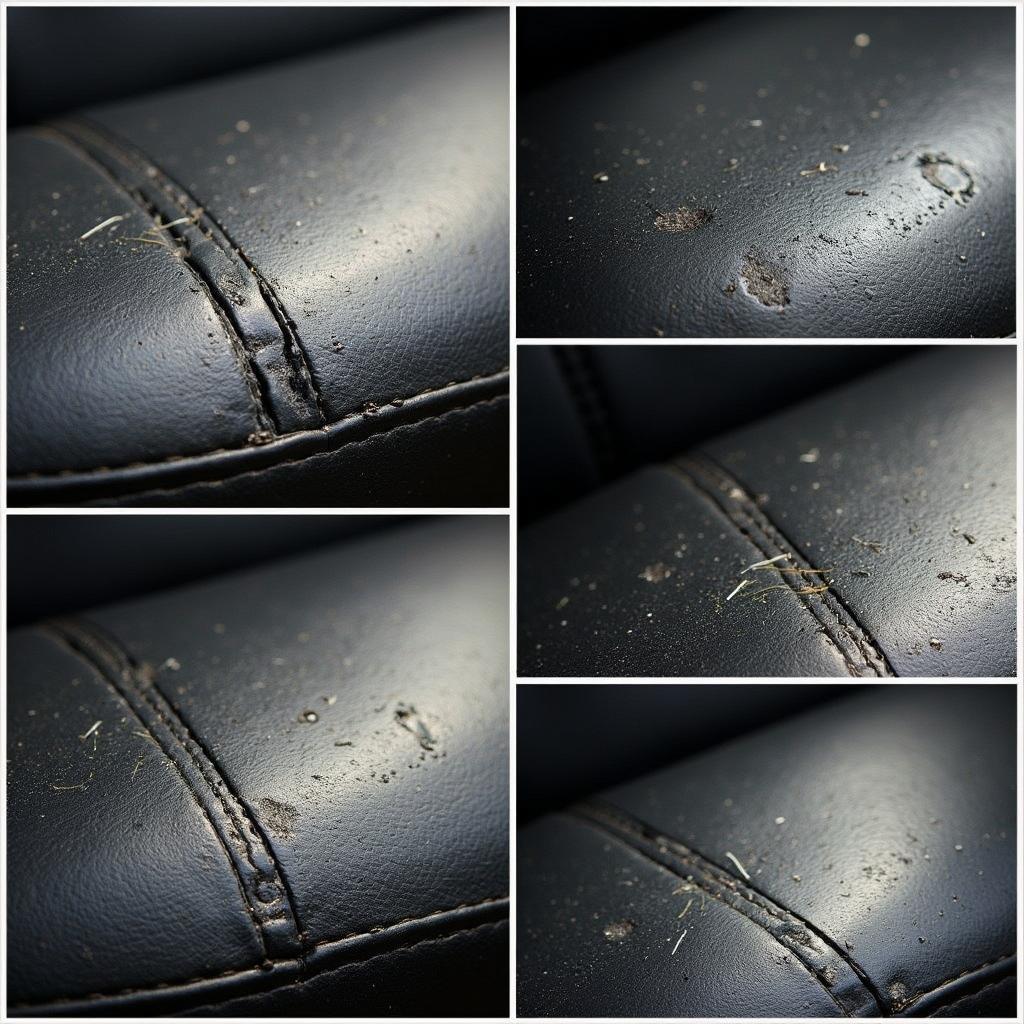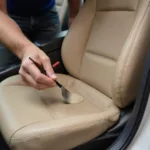Leather car seats instantly elevate a vehicle’s interior, adding a touch of luxury and sophistication. However, over time, wear and tear can take a toll on leather upholstery, leaving it looking worn, faded, and even damaged. Thankfully, with professional car seat leather repair, you can restore your car’s interior to its former glory.
This comprehensive guide delves into the intricacies of car seat leather repair, covering everything from common types of damage to DIY solutions and professional repair options.
Understanding Leather Car Seat Damage
Before diving into repair methods, it’s crucial to identify the type of damage your leather car seats have sustained. Common issues include:
- Cracks and Tears: These are often caused by sharp objects, excessive dryness, or prolonged exposure to sunlight.
- Scratches and Scuffs: Minor surface damage that can occur from everyday use, like rubbing against clothing or accidentally dropping items.
- Fading and Discoloration: Prolonged exposure to sunlight can bleach leather, while spills and stains can also cause discoloration.
- Stains: Food, drinks, and ink are notorious culprits for leaving unsightly marks on leather upholstery.
- Wear and Thinning: High-traffic areas like the driver’s seat often experience thinning leather due to repeated friction.
Understanding the specific issues with your car seats will help you determine the most effective repair approach.
DIY Car Seat Leather Repair
For minor damage, DIY repair kits and techniques can be a cost-effective solution.
Car Seat Leather Repair Kits
audi car seat leather repair kit and similar kits typically include:
- Leather Cleaner: Removes dirt, grime, and surface stains.
- Leather Filler: Used to fill in cracks, scratches, and minor tears.
- Colorant/Dye: Restores the leather’s original color or changes it entirely.
- Sealer: Protects the repaired area and prevents future damage.
When using a DIY repair kit, always follow the manufacturer’s instructions carefully. Test the products on a hidden area of the seat first to ensure color matching and avoid any unexpected reactions.
Home Remedies for Car Seat Leather Repair
Certain household items can also come in handy for minor leather repairs:
- Olive Oil for Cleaning and Conditioning: Olive oil can help clean lightly soiled leather and restore its natural shine. Apply a small amount to a microfiber cloth and gently rub the affected area.
- Baking Soda for Stain Removal: Make a paste of baking soda and water to lift fresh stains. Apply the paste to the stain, let it sit for a few minutes, then wipe clean with a damp cloth.
While DIY methods can be effective for superficial damage, they might not be suitable for severe issues. For deep cracks, tears, or extensive damage, seeking professional car seat leather repair is recommended.
Professional Car Seat Leather Repair
Professional detailers and automotive upholstery specialists have the expertise and tools to handle complex leather repairs.
When to Consider Professional Repair
- Deep Cracks and Tears: These require specialized techniques and materials to ensure a durable and seamless repair.
- Extensive Damage: When multiple areas of your car seats are damaged, a professional can provide a comprehensive restoration.
- Color Matching and Refinishing: Professionals have access to a wide range of colorants and dyes to perfectly match your car’s original leather color.
- Intricate Detailing: If your car seats have intricate stitching or patterns, a professional can ensure the repairs blend seamlessly.
Benefits of Professional Leather Repair
- High-Quality Results: Professionals deliver lasting repairs that enhance the look and value of your car.
- Time-Saving: DIY repairs can be time-consuming, especially for extensive damage. Professionals have the experience to complete repairs efficiently.
- Increased Car Value: Well-maintained leather seats are a significant selling point when it’s time to trade in or sell your vehicle.
Car Seat Leather Repair Cost
The cost of car seat leather repair varies depending on several factors, including:
- Extent of Damage: Minor scratches cost less to repair than deep cracks or tears.
- Type of Repair: Simple cleaning and conditioning cost less than color restoration or panel replacement.
- Location: Labor costs can fluctuate depending on your geographical location.
- Service Provider: Reputable specialists might charge higher prices but often deliver superior results.
To get an accurate estimate, contact several car seat leather repair shops in your area.
“When it comes to car seat leather repair, it’s always advisable to consult with a professional. They can assess the damage, recommend the best course of action, and provide a transparent cost breakdown.” – John Smith, Automotive Upholstery Expert at Smith’s Auto Detailing.
Preventing Future Leather Car Seat Damage
Prevention is key to maintaining the pristine condition of your leather car seats. Here are some tips:
- Regular Cleaning: Clean your seats regularly using a leather cleaner and a soft microfiber cloth.
- Conditioning: Use a leather conditioner to keep the leather supple and prevent drying and cracking.
- UV Protection: Park your car in the shade or use a windshield sunshade to protect your leather from harmful UV rays.
- Avoid Sharp Objects: Be mindful of sharp objects that can scratch or puncture the leather.
By incorporating these preventive measures into your car care routine, you can significantly extend the lifespan of your leather car seats and preserve their luxurious appeal.
FAQs
Q: Can I use regular household cleaners on my leather car seats?
A: No, using harsh household cleaners can strip the leather of its natural oils, leading to dryness, cracking, and discoloration. Always use cleaners specifically formulated for leather.
Q: How often should I condition my leather car seats?
A: It’s recommended to condition your leather car seats every three months or more frequently if they are exposed to extreme temperatures or sunlight.
Q: Can I change the color of my leather car seats during repair?
A: Yes, professional leather repair specialists can re-dye your car seats to restore their original color or change it entirely.
Q: How long does car seat leather repair take?
A: The repair time depends on the extent of the damage. Minor repairs can be completed within a few hours, while more extensive damage may require a few days.
Q: Is car seat leather repair covered by insurance?
A: Car insurance typically only covers damage resulting from an accident. Wear and tear are usually not covered.
Q: Can I repair a tear in my leather car seat myself?
A: While DIY kits are available for minor tears, it’s recommended to consult a professional for significant tears to ensure a durable and aesthetically pleasing repair.
Q: How can I find a reputable car seat leather repair shop near me?
A: You can search online for “[car seat leather repair near me](https://carrepairon.com/car-seat leather-repair-near-me/)” to find local businesses. Check online reviews and ask for recommendations from friends or family.
Conclusion
Car seat leather repair is an investment that can revitalize your vehicle’s interior, enhancing both its aesthetics and value. Whether you opt for DIY solutions or professional services, addressing leather damage promptly ensures your car seats remain a source of pride and comfort for years to come.
Remember to explore our website for more informative articles like “how to repair small crack in leather car seat” and “black car seat leather repair dye“. You can also learn about “how much does it cost to repair leather car seat” to make informed decisions about maintaining your car’s luxurious interior.
Need expert assistance with your car’s upholstery? Contact us via WhatsApp: +1(641)206-8880, Email: [email protected]. Our dedicated customer support team is available 24/7 to answer your queries.



